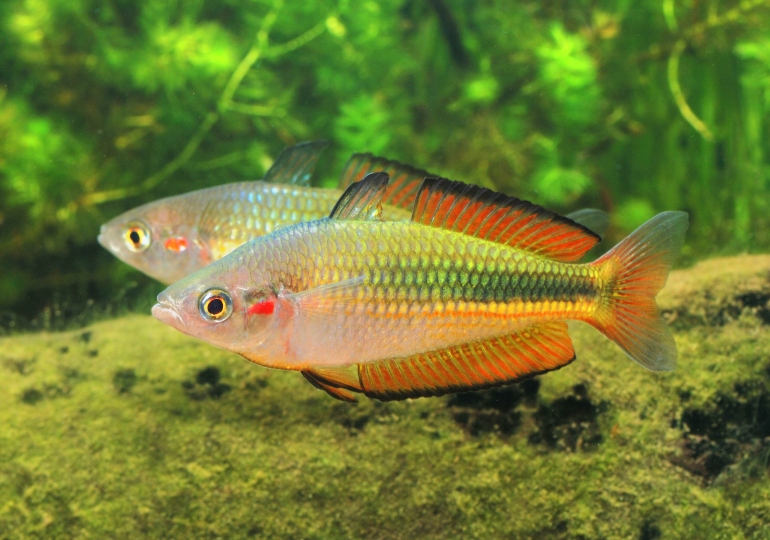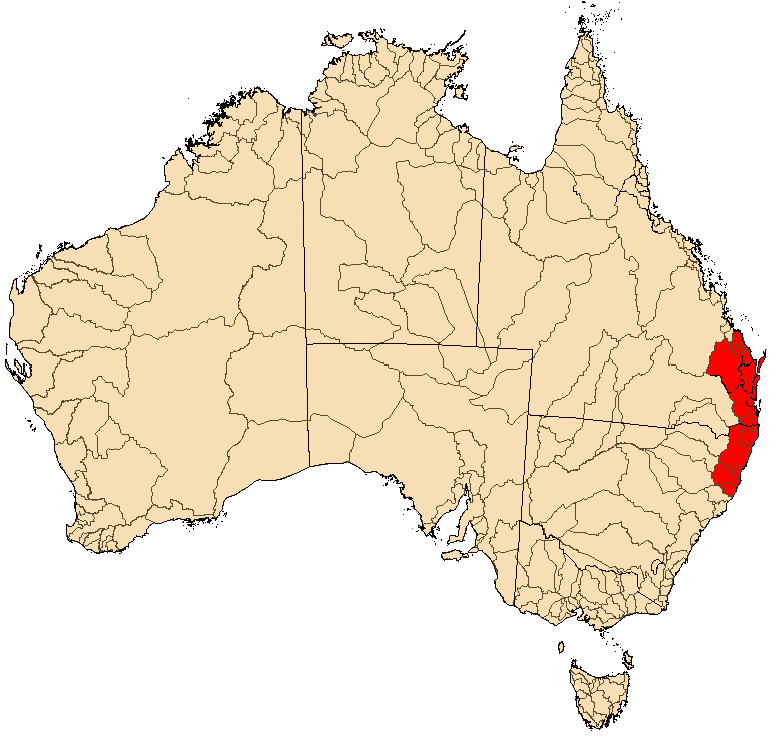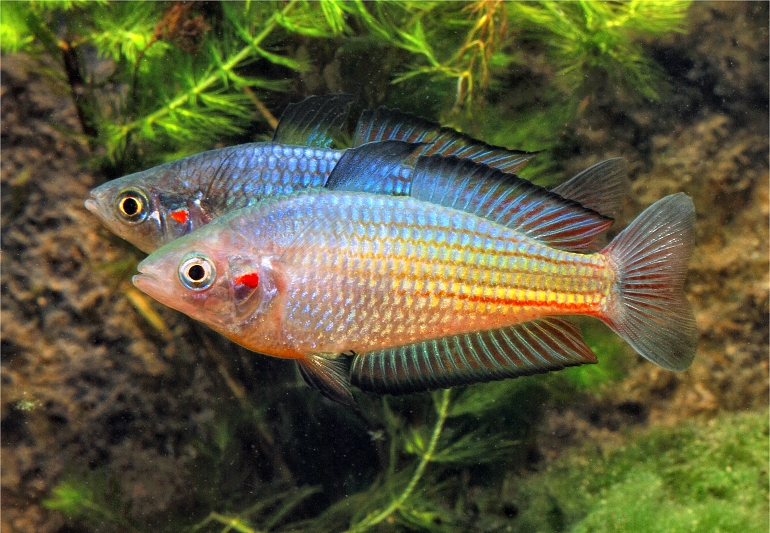|
 |
Melanotaenia duboulayi [Richmond River, NSW] - photo© Gunther Schmida |
(Castelnau, 1878)
Crimsonspotted Rainbowfish
Species Summary
Melanotaenia duboulayi were initially collected in the 1870's from the Richmond River in northern New South Wales by a man named Duboulay (du Boulay). They were later scientifically described as Atherinichthys duboulayi by Castelnau in 1878. They were also later known as Nematocentris fluviatilis and Melanotaenia fluviatilis. Following a review of the rainbowfish group by Allen in 1980, they were reclassified as Melanotaenia splendida fluviatilis. Their current scientific name follows from a study of its early life-history stages by Crowley et al., in 1986. This study resulted in Melanotaenia splendida fluviatilis being separated into two species, Melanotaenia duboulayi from the eastern coastal drainage systems of northern New South Wales and southern Queensland, and Melanotaenia fluviatilis from the inland Murray-Darling River system.
Melanotaenia duboulayi can reach a maximum size of 12 cm SL, but are usually less than 10 cm. They have a slender and compressed body shape with depth increasing with age. Two dorsal fins, very close together, the first much smaller than the second. They exhibit considerable colour variations over their wide geographical range. Generally, the body is silvery-blue or green ranging through deep bluish or yellow tones. The scale rows are marked with narrow yellow lines and overlaid with orange to brilliant red. A prominent spot of crimson red is seen on the operculum, the fin colours are variable from clear, yellowish to red, with red flecks and dark margins. These dark margins become intensely black in males during spawning activities. The larger males are easily distinguished from females by their brighter colours and can usually be identified from the elongation of posterior rays in the second dorsal and anal fins. Females have rounded dorsal and anal fins, which are smaller and lack the dark edges.
Melanotaenia duboulayi are not easily distinguished from Melanotaenia fluviatilis. Principal variations are body depth, fin counts, and colour pattern. In addition, there are clear differences in egg characteristics and larval development. Melanotaenia fluviatilis often have a broader head and blunter snout compared to Melanotaenia duboulayi.
 |
Distribution Map |
Distribution & Habitat
Melanotaenia duboulayi inhabits the coastal drainages east of the Great Dividing Range from the Hastings River in New South Wales, approximately 400 km north of Sydney to Baffle Creek, between the cities of Bundaberg and Gladstone in southern Queensland. They are a subtropical species found in relatively still, clear water, in water temperatures between 11-34°C. Habitat includes freshwater rivers, streams, billabongs, reservoirs, swamps, and lagoons with dense aquatic vegetation. Their natural environment is subjected to seasonal variations with water temperature, pH and hardness levels varying considerably.
Melanotaenia splendida occupies the east coast drainages of Queensland north of the Burnett River region in the south, to Scrubby Creek, just south of the Lockhart River in the north. The exact species boundaries are unknown and it may be that these two species live sympatrically in some locations. Natural hybrids of M. splendida and M. duboulayi have been reported from Deepwater Creek and Mullett Creek.
Melanotaenia duboulayi are usually found in open water areas and around sub-surface vegetation, submerged logs, or branches in mid to lower depths. They usually spend most of their time in the open water areas where they form small groups, with one or two fish breaking away to explore occasionally. The behaviour between the sexes also appears to vary with females forming the basis of the group while the males cruise in search of spawning or feeding opportunities. In sunny conditions groups of juveniles occurred near the water surface feeding on floating material at the surface, but larger fish tended to occur at the bottom near submerged vegetation, often utilizing the aquatic plants as a refuge and food source. In the middle of the day, juveniles and small fish seemed to show behavioural thermoregulation at the surface in the warmest site. Under cloudy conditions, however, fish of all sizes preferred deeper water.
Water Quality
Water quality is influenced by seasonal conditions, water depth, flow rates, time of day when measurements are recorded, and the presence and density/nature of riparian vegetation. Conductivity levels are generally higher during the dry season when no fresh water is flowing into the catchment. By the end of the dry season evaporative loss causes a progressive increase in conductivity with a greater than tenfold solute concentration factor. Conductivity generally increases the further downstream you go along a river, but significant discontinuities in this gradient can occur at points of confluence with other tributaries and groundwater springs, etc. The slightly higher pH levels are characteristic of coastal streams as pH tends to increase with salinity.
Water Temperature: 11 - 34°C
pH: 5.8 - 9.0
Alkalinity: 7 - 428 mg/L CaCO³
Hardness: 22 - 483 mg/L CaCO³
Conductivity: 170 - 1959 µS/cm
TDS: 114 - 930 mg/L
 |
Melanotaenia duboulayi [Christmas Creek, Logan River, Qld] - photo© Gunther Schmida |
Biology
Most information on rainbowfish biology is mainly based on aquarium observations. Spawning occurs from September to December before the onset of summer rains. Spawning occurs during the early morning or evening just before dark. Each female lays several eggs a day, which are fertilised by the male. Eggs adhere to fine-leaved foliage plants or among the roots of floating vegetation by several long, thin filaments originating at one point on the egg membrane. The water hardened eggs have a diameter of 0.98-1.8 mm and hatch after 5-9 days after fertilisation at water temperatures between 24 and 29°C. At hatching, larvae 2.5 to 4.2 mm in length have a reduced but still present yolk-sac. The newly hatched larvae congregate near the water's surface within a few hours and begin feeding within 12 hours. At 32 days after hatching, the mean larval length is about 14-15 mm and at 72 days 21-25 mm. Juvenile fish grow quickly and reach maturity within 10-12 months. Males grow faster and to larger sizes than females. Sexual maturity occurs at about 4-5 cm for both sexes. Strong sexual dimorphism is present in the species with males typically being larger and brighter in colouration.
 GES.jpg) |
Melanotaenia duboulayi [Albert River, Qld] - photo© Gunther Schmida |
Remarks
Melanotaenia duboulayi is the original "Australian Rainbowfish" and were being maintained in the aquarium hobby around the turn of the twentieth century. Melanotaenia duboulayi were commonly known as the 'Crimson-spotted Sunfish' and mistakenly identified as Melanotaenia nigrans. Amandus Rudel was a founding member of the Aquarium & Terrarium Society of Queensland, and in 1927 he introduced the Australian rainbowfish to the international aquarium hobby when he sent specimens of Melanotaenia duboulayi by steamship to Germany, and which were later bred by the Berlin Aquarium. Speaking of Melanotaenia duboulayi, Amandus said, "I was astonished at the beauty of this fish the first time I saw it. Like a living rainbow, there is no other fish which can compare with its beauty. Naturally it has been my favourite ever since."
It is believed that from this initial shipment Melanotaenia duboulayi were introduced to the organised aquarium hobby throughout Europe, and then to North America. They are probably the species upon which today's common name "Rainbowfish" is based. In 1930 a number of Melanotaenia duboulayi were collected in the Mississippi River. Three specimens were collected in July 1930 by Mr. Fred G. Orsinger of the John G. Shedd Aquarium, Chicago, Dr. Wilbur Luce of the University of Illinois and Dr. Thompson of the Illinois State Natural History Survey. They were taken in a minnow seine, near the edge of a sand bar in the Mississippi River, out from the Southern Illinois Penitentiary. They were taken alive to the Shedd Aquarium, where they were identified by Dr. Carl Hubbs of the University of Michigan. It is supposed that they may have escaped from some tropical fish establishment in St. Louis, some 40 miles up-stream. This was one of the earliest accounts of an introduced ornamental fish found in the USA.
 GS.jpg) |
Melanotaenia duboulayi [Bremer River, Qld] - photo© Gunther Schmida |
Literature
Allen G.R. (1980) A Generic Classification of the Rainbowfishes (Family Melanotaeniidae). Records of the Western Australian Museum 8 (3): 449-490.
Castelnau F.L. (1878) On several new Australian (chiefly) fresh-water-fishes. Proceedings of the Linnean Society of New South Wales V.3 (pt 2): 140-144.
Crowley L.E.L.M., W. Ivantsoff and G.R. Allen (1986) Taxonomic Position of Two Crimson-spotted Rainbowfish, Melanotaenia duboulayi and Melanotaenia fluviatilis (Pisces: Melanotaeniidae), from Eastern Australia, with Special Reference to Their Early Life-history Stages. Australian Journal of Marine and Freshwater Research 37: 385-98.
Hattori A. & K. Warburton (2003) Microhabitat use by the rainbowfish Melanotaenia duboulayi in a subtropical Australian stream. Journal of Ethology 21(1): 15-22.
Milton D. & A. Arthington (1984) Reproductive strategy and growth of the crimson-spotted rainbowfish, Melanotaenia splendida fluviatilis (Castelnau) (Pisces: Melanotaeniidae) in south-eastern Queensland. Marine and Freshwater Research 35(1): 75-83.
O'Donnell D.J. (1935) Annotated list of the fishes of Illinois. Illinois Natural History Survey Bulletin 20(5): 473-500.
Adrian R. Tappin
Updated September, 2015



|

